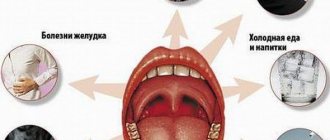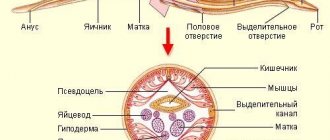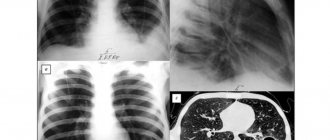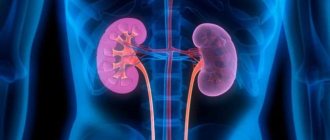Causes of cancer
It is impossible to determine whether you have the disease.
This is only possible through a comprehensive examination. Modern medicine today has not fully figured out why this disease appears. It only takes one mutated cell to start cancer. Subsequently, it begins to multiply very quickly and causes the situation to worsen. Scientists have identified some negative effects on cells leading to their mutation:
- hereditary factor;
- ionizing radiation;
- carcinogens;
- viruses.
While it is still possible to protect yourself from ionizing radiation and exposure to ultraviolet radiation, it is impossible to protect yourself from hereditary factors. And carcinogens can often be found not only in drugs or chemicals, but also in common food. Also harmful are viruses that can integrate into DNA and lead to its mutation.
Thrombophilia
Thrombophilia is a group of diseases in which the blood coagulation system is over-activated, which causes the pathological formation of clots and blood clots. Thrombophilia can be acquired - such as antiphospholipid syndrome, as well as congenital or genetic - in the presence of active (triggered) mutations of hemostasis genes. The presence of a predisposition—detected mutant genes, high levels of homocysteine, the presence of antiphospholipid antibodies—is a significant risk factor for the development of thrombosis of various locations.
The risk of thrombosis increases significantly if you have a predisposition to smoke, are overweight, have a folate deficiency, take oral contraceptives, or lead a sedentary lifestyle. In pregnant women, the risk of thrombosis in the presence of mutations in hemostasis genes is even higher; in addition, the likelihood of fetal loss at any stage of gestation increases.
Complication of thrombophilia
Depending on the type of thrombophilia, it is possible to prevent the development of pathology by taking folic acid and other B vitamins, maintaining an active lifestyle, avoiding the use of oral contraception, and monitoring hemostasis in preparation for and during pregnancy. Prophylactic doses of antiplatelet agents and anticoagulants may also be needed - it all depends on the actual situation and medical history.
To diagnose thrombophilia, the doctor prescribes:
- hemostasis genes: F2, F5, PAI-1, fibrinogen;
- folate cycle genes, homocysteine;
- antibodies to phospholipids, cardiolipin, glycoprotein;
- lupus anticoagulant;
- hemostasiogram with RFMC and d-dimer.
Thrombophilia can be expressed in thrombosis of the veins of the lower extremities, thrombophlebitis, hyperhomocysteinemia, thromboembolism, in pregnant women - gestosis and eclampsia, sclerosis and thrombosis of chorionic villi, which leads to fetal hypoxia, oligohydramnios and even fetal death. If pregnant women with a burdened obstetric history have never had evidence of thrombosis, then to increase the chances of pregnancy it is possible to prescribe antiplatelet agents, since in this group of patients excessive aggregation of blood clots is observed from the first trimester.
Diagnosis
Enlarged liver and lymph nodes are the first signs of the disease.
It is impossible to independently understand the disease and make a diagnosis. After all, cancer can develop gradually and no symptoms appear. This especially happens in the first stages. There are acute and chronic forms. While the acute form can still appear quickly, the chronic form sometimes takes several years to develop.
Therefore, an oncologist is needed for an accurate diagnosis. He will prescribe a general blood test and biochemical test. A bone marrow test will also be required. Only these studies can accurately tell about the presence of the disease and its form.
Acute symptoms
At an early stage, the symptoms of the acute form will differ from the symptoms of the late stage. First of all, the patient may experience frequent bleeding. Trying to stop them takes a lot of time and is really difficult to do. The patient also develops painful joints, numerous blood smears throughout the body or bruises.
The lymph nodes become enlarged, and the liver is often enlarged. A person becomes lethargic, gets tired quickly, and often suffers from various infectious diseases. Later, nausea and motion sickness occur, as in transport. At night, sweat is constantly released. In a short time, a person quickly loses weight without any obvious visible reasons.
In the later stages, the patient's lips and nails acquire a blue tint, and frequent pain in the heart area appears. The temperature increases and often stays around 38 °C. Tachycardia, anxiety, and difficulty breathing occur.
Blood leukemia symptoms in adults causes
In fact, leukemia has recently begun to increasingly affect the adult population.
And now about 75% of all cases are over 40 years of age. Every year, more than 280,000 people worldwide suffer from this disease, and approximately 190,000 die. Every year, new methods and types of treatment appear that have reduced the mortality rate. Blood leukemia, or leukemia as it is also called, is an oncological disease, the pathological process of which affects the hematopoietic system located in the bone marrow. At the same time, the number of immature and mutated leukocytes in the blood begins to increase. In common parlance, this disease is also called leukemia. Acute and chronic leukemia are divided.
Typically, the incidence of this disease increases in older people over 55-60 years of age. Most often, older people suffer from acute myeloblastic leukemia. Younger ones, 10-20 years old, already suffer from chronic lymphoblastic pathology. For people over 70 years of age, another form of blood cancer is usually characteristic - myeloblastic leukemia.
If we take children, then they have one of the most dangerous types of blood oncology - acute lymphoblastic leukemia, and more often it affects boys from 2 to 5 years old. The acute form of myeloblastic leukemia already accounts for 27% of all cancers among children and affects children from 1 to 3 years old. And most often the prognosis is very disappointing, since the disease is very aggressive and progresses quickly.
Chronic
| Forms of cancer | Disease |
| Lymphoproliferative | myeloma pathology |
| heavy chain disease | |
| chronic lymphocytic leukemia | |
| multiple myeloma | |
| Myeloproliferative | essential thrombocythemia |
| erythremia | |
| subleukemic myelosis | |
| chronic myeloid leukemia |
Causes
Scientists and doctors are still arguing about what exactly influences the occurrence of cancerous and malignant cells. But most doctors are already on the path to discovery, since most believe that both acute and chronic forms of leukemia arise as a result of pathology at the level of chromosomes within cells.
Recently, scientists discovered the so-called “Philadelphia chromosome”, which is located in the bone marrow and can lead to blood cancer - a mutation of red bone marrow cells. But as studies have shown, this chromosome becomes acquired during a person’s life, that is, it cannot be obtained from parents.
Acute myeloid leukemia occurs in people with Bloom syndrome, Down syndrome, Fanconi anemia, and in patients with Wiskott-Aldrich syndrome. Let's take a closer look at all the other factors that may influence the occurrence of this disease:
- Smoking. Cigarette smoke contains a huge amount of chemicals that directly affect blood cells when inhaled.
- Alcohol and nutrition. One of the endogenous factors that affect the entire body and every cell. In people with poor nutrition and problems with alcohol, the risk of developing cancer of any class increases by one and a half times.
- Working with hazardous chemicals. People who work in factories, laboratories, or with plastic, gasoline, or other petroleum products have an increased chance of getting sick.
- Chemotherapy and Radiotherapy. It happens that when treating a tumor, complications arise and another cancer appears.
- Immune deficiency . Any disease that weakens the immune system can lead to cancer.
- Genetics. Children whose parents had leukemia have a higher chance of getting the disease than the average child. Such people are usually included in the risk group, and they must undergo the necessary examinations annually.
To put it simply, first there is some external or internal effect on the cell. Then inside at the chromosomal level, it changes and mutates. After this cell divides, there are more of them.
When a mutation occurs, the division program breaks down, and the cells themselves begin to divide faster. The death program also breaks down, and as a result they become immortal.
And all this happens in tissues in the red bone marrow, which reproduce blood cells.
As a result, the tumor itself begins to produce underdeveloped leukocytes, which simply fill all the blood. They interfere with the work of red blood cells and platelets. And later there are many times fewer red blood cells.
Symptoms
Symptoms primarily depend on the type of leukemia and the stage of the cancer itself. It is clear that in later stages the symptoms are more vivid and more pronounced. Plus, other symptoms of the disease may appear. General signs of leukemia in adults:
- Pain in bones and muscles.
- Lymph nodes throughout the body become very enlarged and hurt when pressed.
- The patient more often begins to suffer from common colds and viral diseases - due to the deterioration of the immune system.
- Due to infection, fever and chills appear.
- Sharp weight loss of up to 10-15 kg in an adult.
- Loss of appetite.
- Weakness and rapid fatigue.
- I constantly want to sleep.
- Bleeding does not stop for a long time and wounds on the body do not heal well.
- Leg pain.
- Bruises on the body.
- Adult women may experience bleeding from the vagina.
First symptoms
The problem is that at the initial stage the disease manifests itself poorly, and the patient thinks that it is a common disease. Because of this there is a loss of time. The first symptoms of leukemia in adults:
- Increased size of the liver and spleen.
- You may notice slight bloating in the abdomen.
- The appearance of a rash, red spots on the body.
- Bruising may occur.
- The symptoms are similar to a cold.
- Slight dizziness.
- Joint pain.
- General malaise.
The first signs of leukemia are not so bright, so first of all you need to pay attention to a sharp decline in immunity and frequent illnesses. A patient can get sick, recover, and then start getting sick again a couple of days later. This is due to the fact that there are many immature mutant leukocytes in the blood that do not perform their function.
A decrease in the number of platelets leads to bleeding, rash, stars appearing on the skin or subcutaneous bleeding. In the acute form of leukemia, chills and fever first appear, and then bones and muscles begin to ache.
Symptoms of acute leukemia
Acute leukemia usually progresses rapidly and aggressively. Often, up to stage 4, the disease can develop within 6-8 months, which is why the mortality rate for this pathology is higher than for the chronic form. But at the same time, cancer begins to manifest itself earlier, so in this case you need to see a doctor in time and diagnose cancer. Symptoms of acute leukemia in adults:
- Weakness, nausea, vomiting.
- Dizziness
- Body cramps
- Memory impairment
- Frequent headaches
- Diarrhea and diarrhea
- Pale skin
- Heavy sweating
- Cardiopalmus. Heart rate 80 -100
Symptoms of chronic leukemia
It is a slow and non-aggressive cancer that develops over several years. In the first stages it is almost impossible to recognize it.
- Frequent colds
- A hard and enlarged abdomen is due to an enlarged spleen and liver.
- The patient quickly loses weight, without any diets.
Symptoms of chronic lymphoblastic leukemia
Lymphocytic leukemia occurs more often in adulthood after 50 years. At the same time, there is an increase in lymphocytes in the blood. With an increase in -lymphocytes, it has the form of lymphocytic leukemia.
- Disruption of the entire lymphatic system.
- Anemia.
- Long-term colds.
- Pain in the spleen.
- Visual impairment.
- Noise in ears.
- May lead to stroke.
- Jaundice.
- Bleeding from the nose.
Diagnostics
Usually, with any cancer, the level of platelets and red blood cells in the blood drops significantly. And this is clearly visible on a general blood test. Plus, an additional biochemistry test is usually taken, and there you can see abnormalities with an enlarged liver and spleen.
Source: //ogomeopatii.ru/lejkoz-krovi-simptomy-u-vzroslyh-prichiny/
Symptoms of the chronic form
Chemotherapy can suppress the immune system and completely destroy living cells.
Not everyone can withstand chemistry. Usually the onset of the chronic form does not manifest itself at all. Therefore, a person can live for several years without noticing the onset of the disease. When examining blood, you can see an increased number of granular-type leukocytes. Subsequently, secondary tumors appear, lymph nodes are affected, and the liver enlarges. If treatment is not started on time, complications arise. They are expressed in the form of metastases, bone cancer and other complications.
Classification of blood diseases:
The key point in the development of the disease is pathology at one of the levels of hematopoiesis.
Hematopoiesis scheme
The range of diseases that can be detected includes:
Anemia:
- deficiency anemia (iron deficiency, B12 deficiency, folate deficiency);
- hereditary dyserythropoietic anemia;
- posthemorrhagic;
- hemolytic;
- hemoglobinopathies (thalassemia, sickle cell anemia, autoimmune, etc.);
- aplastic anemia.
Hemorrhagic diathesis:
- hereditary coagulopathies (hemophilia, von Willebrand disease, rare hereditary coagulopathies);
- acquired coagulopathies (hemorrhagic disease of newborns, deficiency of vitamin K-dependent factors, DIC syndrome);
- hemostasis disorders of vascular and mixed origin (Rendu-Osler disease, hemangiomas, hemorrhagic vasculitis, etc.);
- thrombocytopenia (ideopathic thrombocytopenic purpura, alloimmune purpura of newborns, transimmune purpura of newborns, heteroimmune thrombocytopenia);
- thrombocytopathies (hereditary and acquired).
Hemoblastoses:
- myeloproliferative diseases;
- myelodysplastic diseases;
- myelodysplastic syndromes;
- acute myeloid leukemia;
- B-cell neoplasms;
- Histiocytic and dendritic cell neoplasms
Pathologies of the circulatory system are characterized by changes in the quantity of blood elements, their quality, structure and shape with a parallel decrease in their functions. Diagnosis is quite complicated, since a deviation from normal blood counts can occur with almost any other disease of the body. A diagnosed disease requires immediate medical intervention and changes in diet.
Treatment
If blood cancer is detected, treatment must begin immediately. Cancer is completely curable if you start fighting it in time. Treatment is carried out using several methods:
- chemotherapy;
- transplantation;
- radiation therapy.
Treatment is selected according to the stage of the disease and its complications. The oncologist determines how to treat the cancer and what methods are best for it. In some cases, one treatment method is combined with another to better kill cancer cells.
Chemotherapy treatment
Using this therapy helps destroy cancer cells. For “chemistry”, special preparations are used. They have a strong effect on the human body. The drugs are very toxic, but can have a detrimental effect on cancer cells. Almost all patients can treat blood cancer in this way. The selection of drugs and dosage are prescribed purely individually.
Chemotherapy, in addition to its detrimental effect on blood cancer, has a bad effect on other organs and systems. But this effect is less than on the cancer itself. Therefore, this treatment is often chosen. The stage of cancer, the patient’s age and existing diseases must be taken into account.
Drugs are administered to the body orally or intravenously. Chemotherapy is not taken continuously, but cyclically, after certain periods of time. When taken, side effects are sure to occur. Hair may fall out, nausea, intoxication of the body are observed, the mucous membranes of the stomach and intestines are affected, resulting in vomiting. Also, under the influence of the drug with cancer cells, healthy cells can die.
Transplantation for cancer
Sometimes doctors choose a bone marrow transplant. This treatment method is based on the introduction of pre-prepared bone marrow into the body. Hematopoietic stem cells can also be used. This operation is performed after the body has been subjected to special immunosuppressive therapy - when large doses of immunosuppressants are used. In the future, this will help the body not to reject the transplanted bone marrow.
Before the transplant, the oncologist may prescribe other methods to reduce the presence of cancer cells. This will help free up space for the transplanted bone marrow to continue producing normal cells.
To carry out such an operation and cure the patient, it is important to choose the right donor. It must fit perfectly, otherwise the operation will be unsuccessful and the body will simply reject the new material.
Radiation therapy
Cancer is treated with radiation therapy. This technique is based on ionizing rays. They affect cells with mutations, disrupting their structure. This leads to the cancer cell not performing its functions and it dies. Even if it does not die, it will certainly lose its ability to reproduce.
This therapy has worked well. Since cancer cells divide continuously, radiation therapy can significantly slow down this process. Sometimes only this treatment method is enough, and transplantation is no longer necessary.
Still, there are side effects - intoxication of the body, nausea, hair loss. The body is weakened, which can lead to new infections. Therefore, it is very important to protect the patient from various infectious diseases during this period. This will only complicate his condition.
DIC syndrome
Disseminated intravascular coagulation develops as a result of concomitant pathology, which stimulates the organs of the circulatory system to hypercoagulate. The long course of the acute stage of DIC leads to complete destabilization of hemostasis, where hypercoagulation is replaced by critical hypocoagulation. In this regard, therapy varies depending on the stage of the disease - at one stage anticoagulants and antiplatelet agents will be used, while another stage may require a blood transfusion.
Disseminated intravascular coagulation is accompanied by general intoxication, weakness, dizziness, and impaired thermoregulation.
Diagnosis of DIC syndrome
DIC syndrome can be provoked by:
- acute bacterial infection;
- violation of the gravidary period caused by fetal death, placental abruption, eclampsia, amnion embolism;
- serious injury;
- tissue necrosis;
- organ transplantation, transfusion;
- acute radiation sickness, hemoblastosis.
Pathogenesis of DIC syndrome
Treatment of the syndrome is aimed at stabilizing the coagulation and anticoagulation systems, neutralizing blood clots and microclots, restoring adequate function and platelet count with normalizing the aPTT time. Laboratory criteria for the success of therapy are considered to be within the reference values of d-dimer, APTT, RFMC, fibrinogen and platelet count.
Chronic form
The cure for chronic cancer will not be as urgent and active as in the acute form. The disease itself can last for years, so treatment can be gradual and not put too much strain on the body. Sometimes patients with the chronic form can become participants in various experiments with treatment methods. Thanks to them, it is possible to find out the effect of a particular drug on cancer. This shows researchers the effectiveness of the drug and its ability to kill cancer cells.
Patients with chronic blood cancer may be prescribed the same treatment as in the acute form, but in this case the dosage is significantly different. Also, such patients undergo a transplant, but it is not necessary to look for a donor. The cells of the patient himself are ideal. To improve the patient's condition, biological therapy may be added to treatment.
Anemia
One type of anemia can be found in every fourth person on Earth, and most often it is caused by a deficiency of vitamins or microelements. Anemia is a disease in which either the number of red blood cells in the plasma decreases or the hemoglobin content inside the red blood cells decreases. The pathology may owe its development to either a poor-quality diet, or damage to the hematopoietic organs, or massive blood loss, in which the level of hemoglobin in the blood cannot be restored to normal after bleeding. There are also other types of anemia, less common, but more dangerous (genetic, infectious).
Clinical manifestations of anemia
To diagnose anemia, as well as to clarify its type, it is necessary to evaluate the hemoglobin level, the number of red blood cells, hematocrit, red blood cell volume, and the average hemoglobin concentration in a red blood cell.
Table of reference values of blood parameters to exclude anemia
| Index | Reference values | Unit | Note |
| Hemoglobin | 120-140 F 130-160 M | g/l | In pregnant women below 110 g/l |
| Red blood cells | 4.0-5.0 M 3.7-4.8 F | 10^12/l | |
| Hematocrit | 42-50 M 38-47 F | % | |
| Average red blood cell volume | 81-101 | fl | |
| Average hemoglobin concentration in erythrocyte | 32-36 | g/dl | |
| Average hemoglobin content in an erythrocyte | 27-34 | pg | |
| * Eosinophils | 0,5-5 | % | To exclude parasites |
| * Ferritin | 12-150 F 15-200 M | µg/l | To exclude iron deficiency anemia |
| * B12 (cyanocobalamin) | 150-175 | pmol/l | To exclude B12-dependent anemia |
| * B9 (Folic) | 3-25 | ng/ml | To exclude folate-dependent anemia |
Signs and symptoms of anemia
In the presence of helminthic infestations, anemia may develop, since parasites tend to deprive the affected person of a number of nutrients, including those necessary for normal blood composition. If the number of eosinophils exceeds the norm, a specific test is prescribed to find the type of helminth.
Anemia caused by helminthic infestation requires not only anthelmintic treatment, but also the use of a vitamin complex to eliminate vitamin deficiency.
To clarify the nature of anemia, tests are prescribed to assess the level of microelements in the blood - the amount of cyanocobalamin, folic acid and iron in the plasma is examined. If there is a deficiency of one or another component, a medication is prescribed and the diet is adjusted.
Algorithm for separating anemia by erythrocyte indices
Video - Anemia: how to treat
Is a complete cure for blood cancer possible?
The chronic course of leukemia is very peculiar and is characterized by various symptoms.
No oncologist can say for sure whether treatment can completely cure the disease. Since each organism is individual, even the same form of cancer can be treated in different people with different drugs and with a different dosage.
But with timely treatment by the patient and timely treatment, it is quite possible to get rid of the disease. Early treatment increases the chances of complete recovery and normalization of body functions. After treatment, the bone marrow restores its functions and the mutated cells disappear. But it is very important to destroy absolutely all mutated cells, because if even one remains, the disease can start again.
But self-treatment, especially with the help of charlatans and their unknown means, does not help to recover. Gradually, the cancer progresses and becomes more severe. After such “treatment”, the patient goes to the clinic in the last stages of the disease, when it is no longer possible to improve the situation.
Thrombocytopenia and thrombocytopathy
Thrombocytopenia can be either an independent disease due to disruption of the bone marrow or spleen, or provoked by the use of anticoagulant drugs. Thrombocytopenia is characterized by a decrease in platelet count. If this pathology appears while taking heparin, especially in the first 15 days from the start of therapy, it is necessary to urgently discontinue the drug. Most often, this complication is caused by sodium heparin, therefore, with this type of anticoagulant treatment, monitoring of the platelet count, antithrombin 3 level and aPTT is required to avoid the development of bleeding.
Photo of a hand with thrombocytopenia
As an independent disease, thrombocytopenia acts as purpura, which is often congenital and autoimmune in nature. Treatment uses drugs that stabilize hemostasis, as well as drugs that help immune activity.
Thrombocytopathy can act as a hereditary disease with mild symptoms that can be treated by taking vitamins and adjusting the diet.
In the case of thrombocytopenia, an adequate number of blood cells are produced, but they have an altered structure and have inferior functionality. Most often, thrombocytopathy is caused either by taking blood thinning drugs or by a malfunction of the bone marrow. As a result of the disease, the aggregative ability of platelets and their adhesion are impaired. Treatment is aimed at reducing blood loss by taking vitamins and aggregates.
Acquired causes of thrombocytopathy
Why is blood cancer dangerous?
Since abnormal cells appear that cannot perform their normal functions and produce exactly the same cells, they gradually begin to take up a lot of space. As a result, healthy cells begin to be crowded out. There is a shortage of platelets, which causes constant bleeding that is quite difficult to stop.
There is also a lack of red blood cells, which are important for transporting oxygen throughout organs and tissues. Because of this, anemia and oxygen starvation of tissues occur.
Since cancer cells are in the bloodstream, they freely penetrate into the lymph nodes, where they can cause the appearance of a tumor. This further complicates the condition of the body and requires urgent treatment. The oncologist will determine the problem and prescribe all the necessary procedures.
In no case should you change the dosage of chemotherapy on your own or skip cycles - this will allow cancer cells to quickly capture new “territories” and return everything to a worse state again.











